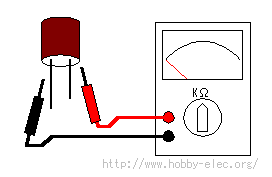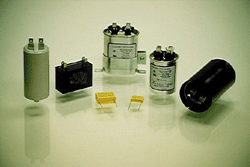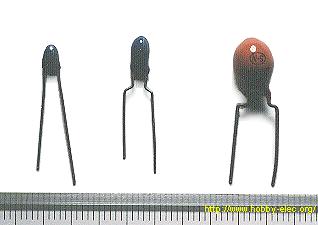 When a DC voltage source is applied to the 10 mF capacitor shown to the left, a charge is stored on each side of the electrode. A mulitmeter is used to measure resistance, it is shown that when the capacitor is charging, current is moving
and when the capacitor is fully charged, the current will stop flowing, because there is no change in electric potenial, so the resistance goes to zero. You can see that when the electodes are switched, the resistance again goes to zero when the capacitor is fully charged.
When a DC voltage source is applied to the 10 mF capacitor shown to the left, a charge is stored on each side of the electrode. A mulitmeter is used to measure resistance, it is shown that when the capacitor is charging, current is moving
and when the capacitor is fully charged, the current will stop flowing, because there is no change in electric potenial, so the resistance goes to zero. You can see that when the electodes are switched, the resistance again goes to zero when the capacitor is fully charged.
AC current is allowed to pass through the conductor continuously because it works similiar to the way the probes are switching, so the current is allowed continuos flow. The main function of a capacitor is for it to store energy and to act as a filter, passing current (AC) and blocking current (DC).
 This image shows a collection of capacitors used in a variety of applications.
This image shows a collection of capacitors used in a variety of applications.
As you can see they come in many different geometric arrangements. The author assumes Gauss's law may be used (for those that have geometric symmetries) to find the electric field in each of these capacitors, and thereby giving a theoretical equation of capacitance for each one shown.
 You can see the number coding on the ceramic capacitor to the left has the number [103] the first two digits represtent the first two real numbers of the value of total capacitance in units of pf the third digit represents the exponent of base ten which is multiplied by the first two digits to give 10 *10^3 pF
You can see the number coding on the ceramic capacitor to the left has the number [103] the first two digits represtent the first two real numbers of the value of total capacitance in units of pf the third digit represents the exponent of base ten which is multiplied by the first two digits to give 10 *10^3 pF
 Here we have a set of tantalum capacitors. They are named tantalum because the material tantalum is used to make them. The tantalum powder is pressed in a high vacuum at approx. 2,100 degrees C. The tantalum pellet is then placed in a forming bath, which allows an oxide to form over the anode surface area. It is then mounted inside a silver cup containing either sulfuric acid or lithium chloride as the electrolyte.(3) Most tantalum capacitors are used in applications where a high values of capacitance are desired, say for analog systems which often are subjected to extremely large temperatures while the charge is being up on one side of the capacitor. This sudden heating is called "spike" which is due to a switch being turned on and off.
Here we have a set of tantalum capacitors. They are named tantalum because the material tantalum is used to make them. The tantalum powder is pressed in a high vacuum at approx. 2,100 degrees C. The tantalum pellet is then placed in a forming bath, which allows an oxide to form over the anode surface area. It is then mounted inside a silver cup containing either sulfuric acid or lithium chloride as the electrolyte.(3) Most tantalum capacitors are used in applications where a high values of capacitance are desired, say for analog systems which often are subjected to extremely large temperatures while the charge is being up on one side of the capacitor. This sudden heating is called "spike" which is due to a switch being turned on and off.